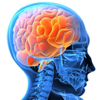Nanoparticle to test for and treat brain tumours
A single compound with dual function – the ability to deliver a diagnostic and therapeutic agent – may one day be used to enhance the diagnosis, imaging and treatment of brain tumours, according to findings from Virginia Commonwealth University and Virginia Tech.
Glioblastomas are the most common and aggressive brain tumour in humans, with a high rate of relapse. These tumour cells often extend beyond the well-defined tumour margins making it extremely difficult for clinicians and radiologists to visualise with current imaging techniques. Researchers have been investigating enhanced methods of attacking these cells in order to possibly delay or prevent brain tumour relapse.
In a study published in the August issue of the journal Radiology, the research team led by Panos Fatouros, Ph.D., a former professor and chair of the Division of Radiation Physics and Biology in the VCU School of Medicine who retired in 2010, demonstrated that a nanoparticle containing an MRI diagnostic agent can effectively be imaged within the brain tumour and provide radiation therapy in an animal model.
The nanoparticle filled with gadolinium, a sensitive MRI contrast agent for imaging, and coupled with radioactive lutetium 177 to deliver brachytherapy, is known as a theranostic agent – a single compound capable of delivering simultaneously effective treatment and imaging. The lutetium 177 is attached to the outside of the carbon cage of the nanoparticle.
“We believe the clustering properties of this nanoplatform prolong its retention within the tumour, thereby allowing a higher radiation dose to be delivered locally,” said Michael Shultz, Ph.D., a research fellow in Fatouros’ lab in the Department of Radiology in the VCU School of Medicine.
“This theranostic agent could potentially provide critical data about tumour response to therapy by means of longitudinal imaging without further contrast administration,” said Fatouros.
A nanoparticle called a functionalised metallofullerene (fMF), also known as a “buckyball,” served as the basis of this work and was created by study collaborator, Harry Dorn, Ph.D., a chemistry professor at Virginia Tech, and his team. In 1999, Dorn and his colleagues were able to encapsulate rare earth metals in the hollow interior of these nanoparticles that can easily be recognised by MRI techniques.
“Although this is a limited animal study, it shows great promise and hopefully this metallofullerene platform will be extended to humans,” said Dorn.
(Source: Virginian Commonwealth University: Radiology)
More information
 | For more information on brain health, including the anatomy of the brain, the effects of nutrition and exercise on the brain, and the effect of mental activity on health, see Brain Health. |
 | For more information on cancer, including breast, prostate, kidney and stomach cancer, see Cancer: Overview. |
Dates
Tags
Created by:

 Login
Login














